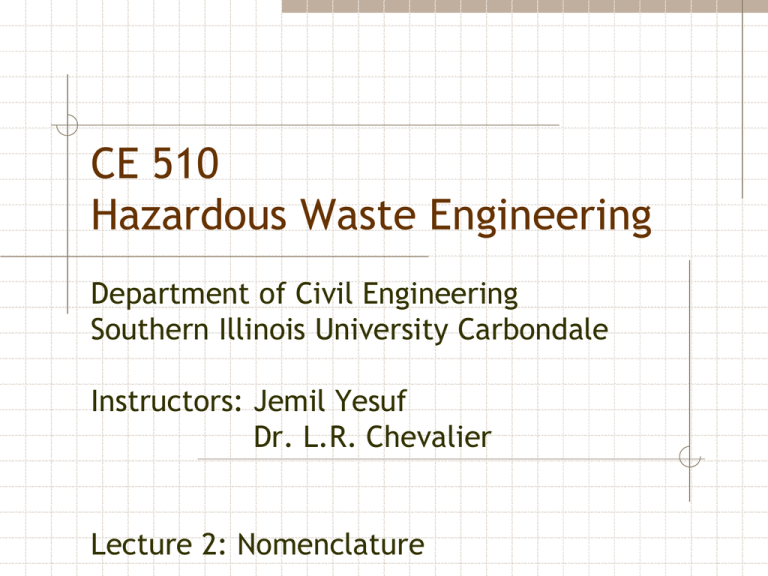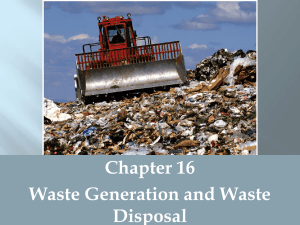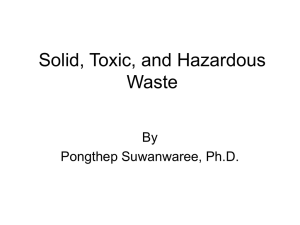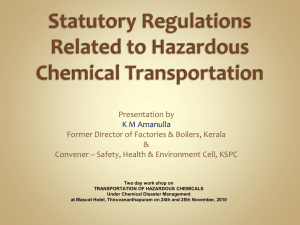
CE 510
Hazardous Waste Engineering
Department of Civil Engineering
Southern Illinois University Carbondale
Instructors: Jemil Yesuf
Dr. L.R. Chevalier
Lecture 2: Nomenclature
Course Goals
Review the history and impact of environmental laws in the
United States
Understand the terminology, nomenclature, and
significance of properties of hazardous wastes and
hazardous materials
Develop strategies to find information of nomenclature,
transport and behavior, and toxicity for hazardous
compounds
Elucidate procedures for describing, assessing, and
sampling hazardous wastes at industrial facilities and
contaminated sites
Predict the behavior of hazardous chemicals in surface
impoundments, soils, groundwater and treatment systems
Assess the toxicity and risk associated with exposure to
hazardous chemicals
Apply scientific principles and process designs of hazardous
wastes management, remediation and treatment
Naming Alkanes
Name of
Compound
Number of
Carbons
Name of
Compound
Number of
Carbons
Methane
1
Undecane
11
Ethane
2
Dodecane
12
Propane
3
Tridecane
13
Butane
4
Tetradecane
14
Pentane
5
Pentadecane
15
Hexane
6
Hexadecane
16
Heptane
7
Heptadecane
17
Octane
8
Octadecane
18
Nonane
9
Nonadecane
19
Decane
10
Eicosane
20
Formula: CnH2n+2
Naming Alkyl Group
Lacks one hydrogen atom relative to the
parent molecule
-CH3 methyl
-CH2-CH3 ethyl
Isomers
Empirical Formula ---Chemical Formula---Structure
ratio
Number of
each atom
i.e. Glucose
CH2O is the empirical formula
C6H12O6 is the chemical formula
Isomers
Empirical Formula ---Chemical Formula---Structure
-
-
-C-C-C-C-C- pentane
isomers
-
-
-C-C-C-C-C-
2-methylbutane
- -
-C-
-C-C-C-C-
2,2-dimethylpropane
-
Isomers
Isomers – Alkyl Groups
-CH2-CH2-CH2-CH3
-
CH3
-CH-CH2-CH3
n-butyl
(n for normal or straight chain)
sec-butyl
bonding to the parent compound
occurs from the second carbon from
the end of the group
Isomers – Alkyl Groups
-
CH3
-CH2-CH-CH3
-
CH3
-
-C-CH3
CH3
iso-butyl
last two carbons are branched
tert-butyl
attachment carbon is bonded to the
other carbons
Isomers – Alkyl Groups
Rules for Naming
International Union of Pure and
Applied Chemist, IUPAC
Chemical Abstract System, CAS
Rules for Naming
Rules for Naming
Class Exercise
Text Problems
Class Exercise
Text Problems
Solution
1a
n-octane
1b
2-methylpropane
1c
2-dimethylpropane
1d
2,5-dimethylheptane
1e
3,4,7-trimethyl-6-isopropylnonane
Solution
1f
7-ethyl-3,4,4,5,-tetramethyl-6-isopropyldecane
1g
6-tert-butyl-3,4,4,5-tetramethylnonane
1h
9-tert-butyl-7-ethyl-3,4,4,5,11-pentamethyl-6isopropylpentadecane
Substitute
Prefix
Br
Bromo-
-
Substitute Groups
Cl
Chloro-
CH3-CH-CH3
F
Fluoro-
I
Iodo-
NH2
Amino-
NO2
Nitro-
Cl
Isopropyl chloride
2-chloropropane
Alkenes
CnH2n
Carbon-carbon double bond
Ethene or Ethylene
C = 2 H = 2(2)=4
H
H
C C
H
H
Alkenes
Class Exercise
Solution
2,4-Dimethyl-1-pentene
6-methyl-cis-3-heptene
Aromatic Compounds
Often depicted by alternating single and double
bonds between carbon atoms joined in a ring. The
most common is benzene:
Benzene
NO2
Nitrobenzene
Substitute
Prefix
Br
Bromo-
Cl
Chloro-
F
Fluoro-
I
Iodo-
NH2
Amino-
NO2
Nitro-
Benzene
Some mono-substituted benzenes that are common
hazardous waste have traditional names for which
there is no systematic basis.
OH
CH3
phenol
toluene
NH2
aniline
COOH
benzoic acid
Benzene
Two or more groups on benzene ring
Cl
Cl
Cl
o- diclorobenze
ortho-diclorobenzene
1,2-diclorobenzene
Cl
p- diclorobenze
para-diclorobenzene
Cl
m- diclorobenze
meta-diclorobenzene
Cl
Special di-substituted benzenes
CH3
CH3
CH3
CH3
CH3
o-xylene (1,2-xylene)
m-xylene (1,3-xylene)
CH3
p-xylene (1,4-xylene)
Special di-substituted benzenes
Polycyclic Aromatic
Hydrocarbons (PAHs)
Two or more benzene rings sharing a
pair of carbon atoms
Polycyclic aromatic hydrocarbons (PAH)
Polynuclear aromatic compounds (PNA)
PAHs
Formed as a contaminant in incomplete
combustion
Fly ash
Residues of incineration
Found in heavier fraction of petroleum
products
Lubricating oils
Asphalt
Cigarette smoke
Barbeque
PAHs
Major source of contamination has
been manufactured gas plants
Residential
Industrial
1000 plants in operation in early 1900’s
Soil and sludges around plants are difficult
to remediate
PAHs
35 IUPAC prescribed compounds
Rules for naming
Table 2.7 p. 70
Table 2.8 p. 74
PAHs
PAHs
PAHs
PAHs
PAHs
Rules for PAHs
PAH’s and Their Characteristics
Class Problem
Text
problem 2.3
a-h
Solution
1,2-xylene (o-xylene)
benzo[a]anthracene
anthracene
toluene
p-cresol
phenanthrene
1,2,4,-trimethylbenzene
pyrene
Industrial Uses
Petroleum
Solvents
Pesticides
Nuclear
Petroleum
Contamination
LUST
Gasoline
Home fuel oil
Central storage tanks (fuel farms)
Unintentional releases
Oil rig blowouts
Pipeline ruptures
Petroleum Phases
Natural gas
Petroleum
Crude oil
Asphalt
Petroleum Products
gasoline
Fuels
fuel oil
diesel
Petroleum
Petrochemical
Feedstock
solvents
plasticizers
Concentration of BTEX
Compound
Weight % in
Gasoline
Toxic Effect
Benzene
0.12-3.50
Leukemia
Toluene
2.73-21.80
Neurotoxicity
Ethylbenzene
0.35-2.86
Neurotoxicity
o-xylene
0.68-2.86
Neurotoxicity
m-xylene
1.77-3.87
Neurotoxicity
p-xylene
0.77-1.58
Neurotoxicity
Total
6.43-36.47
Nonholgenated Solvents
Used by industry for “cold cleaning”
Metal degreasing
Parts cleaning
Paint stripping
Paints
Varnishes
Printing Inks
Nonholgenated Solvents
Hydrocarbons
Fraction of petroleum are solvents
mineral spirits
Additional hydrocarbon solvents
Toluene, turpentine
Also used as a starting material for the synthesis
of polymers
Ketones
Alcohols
Ketones
General Formula
=
O
=
O
R-C-R
R-C-R'
Here R and R’ are different alkyl groups
Naming ketones involves naming each alkyl
group and adding ketone to the end. The alkyl
groups should be in alphabetic order.
Alcohols
Use the hydroxyl group –OH
In IUPAC naming, the –ane of the alkane is replaced
by –anol.
In common naming, the term alcohol is added to the
alkyl radical to name the compound.
Halogenated Solvents
Characteristics compared to Nonhalogenated Solvents
Lower flammability
Higher density
Higher viscosity
Improved solvent properties
High tech pollutant
Highly soluble in groundwater
Low degradability
Common Halogenated Solvents
Methylene chloride
Dichloromethane (IUPAC)
Paint stripper
Decaffeination
H
Cl-C-Cl
Cl
Chloroform
Trichloromethane (IUPAC)
Dry cleaning spot
remover
Cl
Cl-C-Cl
Cl
Carbon tetrachloride
Tetrachloromethane (IUPAC)
Dry cleaning
Fire extinguishers
Banned for toxicity 70’s
- -
- -
- -
H
H-C-Cl
Cl
Common Halogenated Solvents
- -
Cl
Cl-C-CH3
Cl
Cl
1,1,1-trichloroethane (TCA)
H
C=C
Cl
Cl
Cl
Cl PCE
Tetrachlorethene (IUPAC)
C=C
Cl
TCE
Trichloroethene (IUPAC)
Cl
Excellent degreaser
Low toxicity relative
to other chlorinated
solvents
Vapor degreaser
nonflammable, slowly
oxidized
Dry cleaning
Pesticides
Over 900 different pesticides used in
US
25,000 different trade names
500,000 tons applied to crops each
year in US
Insecticides
Herbicides
Fungicides
Pesticides
Debate
Improved public health
Increased food production
Disease vector reduction
Degradation of environment
DDT
1000’s of hazardous waste sites resulting from
improper disposal
Explosives
Primary uses
Mining
Quarry
Highway construction
Demolition
Military
Problems with manufacturing and
storage
Polychlorinated Biphenyls
PCB
Heat-stable oils
Transformers
Hydraulic fluids
Toxic Control Act
Congress banned manufacture and limited
distribution
Still present in thousands of transformers,
capacitors, and other electrical devises such as
motors in refrigerators and freezers
Metals
65 elements
30 widely used by industry
Arsenic, cadmium, chromium, lead, nickel, mercury,
cyanides, asbestos
Conducts electricity
High density
High thermal conductivity
Malleability and ductility
Most common source of hazardous waste
from electroplating industry
Nuclear Waste
Waste management regulated by
Nuclear Regulatory Commission
Mixed hazardous waste and nuclear
sites are regulated under RCRA
Rocky Flats, CO
Hanford, WA
Maxey Flats, KY
Nuclear Chemistry
Simple but adequate model of an atom
The nucleus is
surrounded by a
cloud of
negatively
charged
electrons
Nucleus containing
uncharged neutrons and
positively charged
protons
The atomic number of
the atom is the number
of protons
Nuclear Chemistry
235
92
U
Uranium-235
238
92
U
Uranium-238
The mass number is the
number of protons and
neutrons.
Elements with the
same atomic number
but different mass
numbers are isotopes
Class Problem
What
elements are
described by
the following
nuclear
states?
214
82
X
131
53
X
226
88
X
Solution
214
82
X
Lead
131
53
X
Iodine
226
88
X
Radium
Nuclear Chemistry
Some atomic nuclei are unstable
Also termed radioactive
All elements having more than 83 protons
are naturally radioactive
Possible to produce unstable isotopes, or
radionuclides, or virtually every element
in the periodic table
Spontaneous changes form radiation
Alpha, beta and gamma
Nuclear Chemistry
Alpha radiation: two protons and two neutrons are
emitted from the nucleus
2 protons
2 neutrons
239
94
Reduces the atomic
number by 2
Reduces the mass
number by 4
Pu U
235
92
4
2
Nuclear Chemistry
Reduction in mass number
239
94
Pu U
Reduction in
atomic number
235
92
4
2
Emitted alpha particle
as well as
electromagnetic
radiation,
Nuclear Chemistry
239
94
Pu U
235
92
4
2
Alpha particle can be stopped by skin, but
dangerous if inhaled.
Nuclear Chemistry
Electrons can be emitted from an
unstable nucleus as a result of the
spontaneous transformation of a
neutron into a proton plus an
electron.
90
38
Sr Y
90
39
Nuclear Chemistry
The mass number
remains constant
90
38
Beta (and possibly
gamma) particles
are released
Sr Y
90
39
Note the increase in the atomic number
Nuclear Chemistry
particles penetrate deeper. Can
be stopped with 1 cm lead.
Gamma rays highly energetic.
Easily cause biological damage.
90
38
Sr Y
90
39
Dangers of Radiation
Molecules become unstable
Breakage of chemical bonds
Molecular damage
Formation of new molecules that did not
exist before irradiation
Low level exposure can cause somatic
and/or genetic damage on a slow time
scale
Decay Process
Series of steps
Reduce atomic number (-2) and mass number (-4)
Increase atomic number (+1)
Consider Radon
Causes lung cancer
Chemically inert gas that seeps out of soil and
may accumulate in houses
Intermediate product of naturally occurring
decay chain
Starts with uranium-238
Ends with lead
Decay Process
Decay Process
Series of steps
Reduce atomic number (-2) and mass
number (-4)
Increase atomic number (+1)
Compare to Figure 2.13 p. 130
Source of figure: G.M. Masters, Introduction to
Environmental Engineering, 1997, Prentice Hall.
Class Problem
For each step in the following decay chain, list the
particles emitted
214
84
Po Pb Bi Po Pb
210
82
210
83
210
84
206
82
Solution
214
84
Po Pb Bi Po Pb
214
84
Po Pb
210
82
Pb210
83 Bi
210
83
Bi210
84 Po
210
84
Po Pb
210
82
210
82
206
82
210
83
4
2
4
2
210
84
206
82
Half-Life
An important parameter in
characterizing radioactive material
Time for the decay process to reduce
mass by 50%
Wide range of values
Br 6.4 minutes
238U 4.51 x 109 years
78
Information Source
Contaminant Nomenclature, Structure and Properties
Merck Index
Most widely accepted first-cut reference
Merck Index
2145. p-Chlorobenzotrifluoride. [98-56-6] 1-Chloro-4-(trifluoromethyl)benzene; (4chlorophenyl)trifluoromethane; PCBTF; 4-chloro-a,a,a-trifluorotoluene; Oxsol 100.
C7 H4 ClF3 ; mol wt 180.56. C 46.56%, H 2.23%, Cl 19.64%, F 31.57%.
Environmentally friendly solvent. Prepn: H. S. Booth et al., J. Am. Chem. Soc. 57,
2066 (1935). Mass spectrum: F. Belsito et al., Ann. Chim. 69, 259 (1979).
Photochemical reactivity: M. Khan et al., Atmos. Environ. 33, 1085 (1999). Use as
chemical intermediate: E. R. Lavagnino et al., Org. Prep. Proced. Int. 11, 23 (1979);
M. Beller, A. Zapf, Synlett 1998, 792. GLC/MS determn in fish: M. P. Yurawecz, J.
Assoc. Off. Anal. Chem. 62, 36 (1979). Tox-icology: P. E. Newton et al., Inhalation
Toxicol. 10, 33 (1998). Review: C. H. Hare, Mod. Paint Coat. 88, 30-36 (1998). CF3
Cl
Liquid, strong though not unpleasant aromatic odor. bp 1398. Freezing pt:
7368.mp7348. Flash point (closed cup): 1098F (438C). D 20 1.34 g/cc. d4 25 1.334.
nD 21 1.4469. Vapor pressure
(208): 5.3 mm Hg. Soly in water (258): 29 ppm. USE: Chemical intermediate for
dinitroaniline herbicides, dyes. As dielectric fluid and as solvent.
Copyright ©2002 by Merck & Co., Inc., Whitehouse Station, NJ, USA. All rights
reserved.
Summary of Important Points
and Concepts
Because of the thousands of organic chemicals
classified as a hazardous waste or hazardous
substance, knowledge of organic nomenclature is
essential to understanding hazardous waste
management
Petroleum and its refined products contain hundreds
of different organic compounds. One of the
common sources of petroleum contamination has
been leaking underground storage tanks (LUST)
A wide range of chemicals has been used as
solvents, including petroleum distillates and
benzene
Summary of Important Points
and Concepts
Halogenated solvents have become common
groundwater pollutants due to their high densities,
relatively high water solubilities and long
environmental persistence.
Pesticides are agents that destroy insect, plants,
fungi and other pest organisms, and include a wide
range of toxic organic compounds.
PCBs have been used primarily as transformer oils.
They are highly hydrophobic and persistent
compounds.
Summary of Important Points
and Concepts
Heavy metals commonly present at hazardous
wastes include arsenic, cadmium, chromium, lead,
mercury, and nickel. They are predominantly used
in electroplating. Disposal is a major problem.
Nuclear waste are not regulated under RCRA. Mixed
waste sites are. The sites at Hanford Washington
and Savannah Georgia are the most contaminated of
the 14 nuclear weapons facilities in the US
Best starting source for information on the
nomenclature, structure and industrial uses of most
chemicals found in hazardous waste is the Merck
Index.









![The Politics of Protest [week 3]](http://s2.studylib.net/store/data/005229111_1-9491ac8e8d24cc184a2c9020ba192c97-300x300.png)